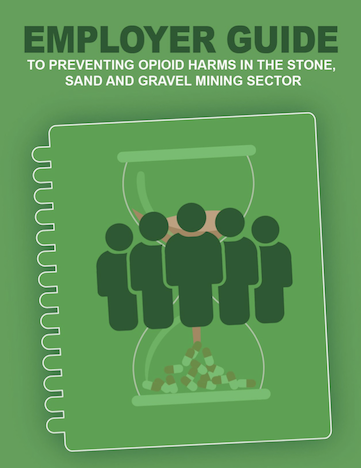By Mark S. Kuhar

Miners in the aggregates industry are at an increased risk to opioid harms such as addiction and overdose. Research shows that they are more likely than other workers to be prescribed opioids for work-related pain, with prescriptions often being of a longer and higher dose than other workers.
To help industry employers create a positive difference in their workplace, a free new guide is available for download: “Employer Guide to Preventing Opioid Harms in the Stone, Sand and Gravel Mining Sector.”
“Mine operators are becoming aware that opioids are affecting their business and that avoidance of the issue isn’t an option,” said Eric Lutz, PhD, CMSP, BSC, director, Mine Safety Center of Excellence at the University of Arizona and founding Member of the Miner Health Partnership. “The guide is an excellent and practical resource to help them get started addressing the opioid issue in a systematic way.”
Developed based on industry input, the guide provides practical tips on how to combat the opioid epidemic in the workplace. “I began this project to help reduce the disproportionate impacts of opioids on the sector,” explained Cora Roelofs, ScD, research faculty, the Center for the Promotion of Health in the New England Workplace. “This guide is the fruit of that research.”
Through conversations with mine operators, Roelofs identified the areas that aggregate producers struggled with and put together an accessible guide that helps them to get started. Rather than providing an overwhelming amount of background information or “perfect” plans, the guide focuses on practical strategies that can be implemented within the constraints that employers face. For example, some actions, such as implementing opioid hazard awareness training or conducting short safety talks, are free. Other supports, including employee assistance programs, may have associated costs.
Tools such as an employer opioid hazard awareness program checklist help employers identify components to consider when developing a program tailored to their own needs while sample policies, which have been vetted by a top industry law firm, cover topics such drug-free workplace policies and a model medications policy. A list of drugs of concern highlights commonly prescribed and over-the-counter medications that can impair reaction time and decision making.
The guide may be particularly helpful for small- and medium-sized producers who don’t have the manpower or specialization to develop these HR policies in house, said Clay Albright, vice president, Caldwell Stone Co., Inc. “I think the guide will definitely help because not everybody has experience with addiction. This could easily be added to the alcohol and substance abuse section of our handbook and help highlight what employers should look for,” he said, adding that it’s important to provide assistance to employees who seek help. “You just have to show a little compassion and understanding to help them get through it. They’re going to appreciate you, and it helps the employer-employee relationship.”
